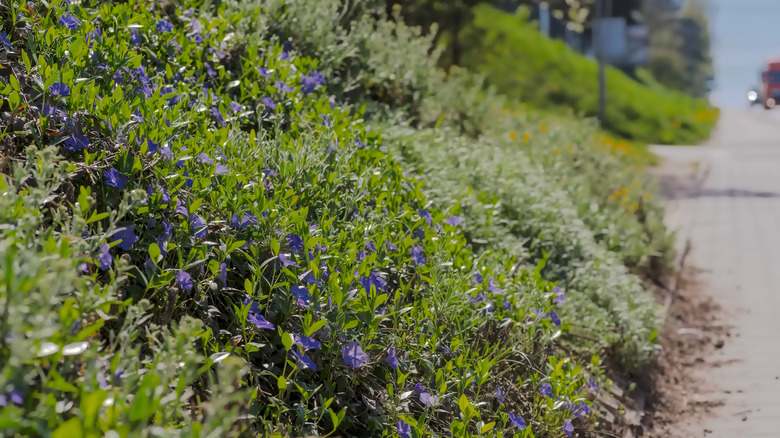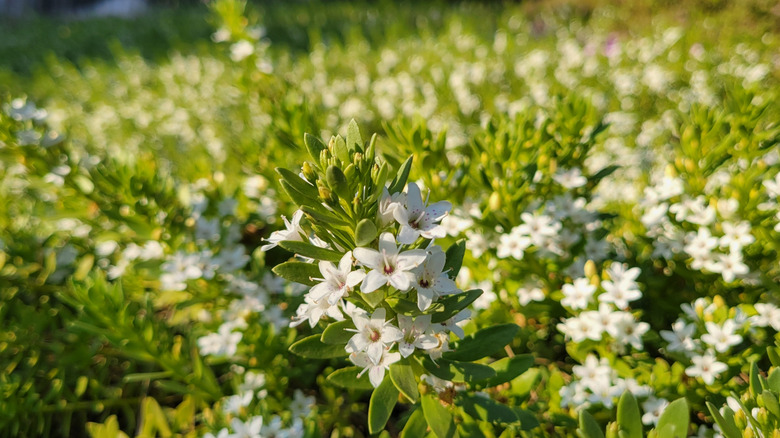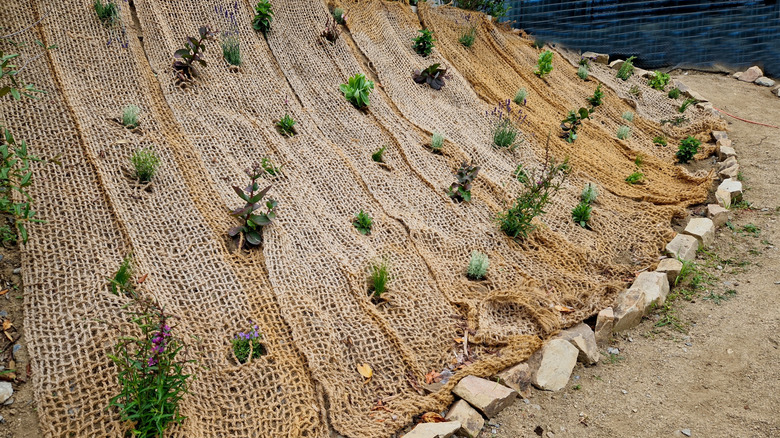The Flowering Ground Cover That Provides Erosion Control For Sloped Yards
No matter how much of a green thumb you have, gardening on a slope is tricky. The soil tends to be drier, and watering, weeding, or mowing the area can be challenging. If you've left your sloped yard bare for a long time because it's just too demanding to maintain, you might also be dealing with heavily eroded, hard, and nutrient-poor dirt that many plants would not want to grow in. Fortunately, an attractive, low-maintenance ground cover like fine leaf form (Myoporum parvifolium) can help control erosion and bring your sloped yard back to life.
Trailing, evergreen plants native to Australia, Myoporum ground covers thrive in hot, dry conditions and tolerate just about any kind of soil. Myoporum parvifolium, in particular, will quickly fill in your sloped yard with a thick, green mat of tiny leaves that lasts all year round. Each spring, watch as an explosion of creamy white flowers carpets your slope.
Once established, the low-maintenance ground cover never gets taller than a foot; most max out at around 6 inches tall. Meanwhile, a single plug can spread out to cover over 6 feet. While the drought-tolerant and heat-tolerant ground cover is excellent for slope erosion control, fine leaf form needs sun and good drainage to thrive. It's also not tolerant of foot traffic, so be sure to leave an unplanted path if you want to be able to navigate around your sloped yard.
Why Myoporum is great for sloped yards
When looking for plants that offer effective erosion control in sloped yards, the species should meet two key criteria. First, it should have a strong, horizontal root system to help hold the soil in place. Secondly, it should have dense foliage on top to block rain from striking the soil directly. Fine leaf form ticks both boxes. The trailing plant grows into thick mats of evergreen foliage while the stems root into the soil as it grows. Covering your slope with fine leaf form can reduce erosion by up to 99 percent compared to leaving the soil bare.
In addition to almost completely stopping erosion, the Australian evergreen is also low maintenance. The low-growing species is short enough to serve as a no-mow alternative to turf grass. It also does well with other stressors that might damage a traditional lawn, like heat, drought, and salt. Once established, it won't need much, if any, ongoing care at all. While in bloom, the pretty, star-shaped flowers emit a light, honey-like scent that makes the spring display even more enjoyable. You can also mix in other fragrant flowering species that tolerate the same sunny, dry conditions as fine leaf form. For example, garden lavender and Myoporum ground cover make a great pair, since both thrive in similar situations and offer beautiful blooms along with a calming, pleasant fragrance.
How to plant Myoporum ground cover for erosion control
To quickly create dense coverage on your sloped yard, space your Myoporum ground cover plugs about 2 feet apart. If you're covering a larger area on a budget, you can space them further apart. Remember, a single plant can spread between 6 and 12 feet wide. It just might take longer to fill in your slope. Either way, you can cover the soil in jute netting and cut out holes to plant your plugs. Doing so helps hold the soil in place while you wait for the Myoporum ground cover to grow in.
Fine leaf form isn't too picky about where you plant it and tolerates some shade. However, it grows more densely if planted in full sun. Even in warmer climates, full sun is still preferable. Thriving in USDA hardiness zones 9 through 11, the evergreen does well during hot summers, even when temperatures climb to 120 degrees Fahrenheit. Myoporum also prefers well-drained soil. In fact, watering too much can cause it to put out weak growth. However, during dry periods, you can water deeply once every 4 to 6 weeks to keep it looking lush and healthy.
While Myoporum needs little to no maintenance once established, gardeners in California should be on the lookout for Myporum thrips. You can try to find a thrip-resistant cultivar. Alternatively, plant companion flowers like daisies, goldenrod, or yarrow to attract minute pirate bugs, a natural predator of thrips and other common garden pests.


